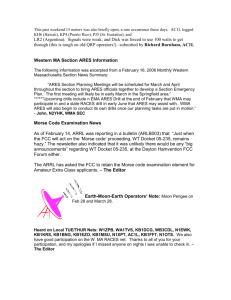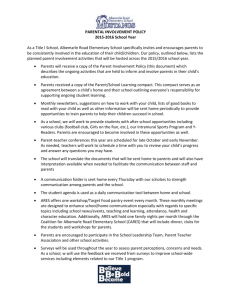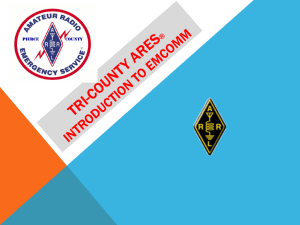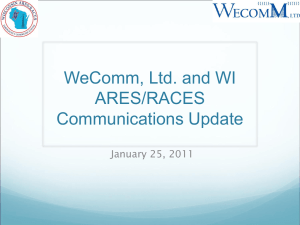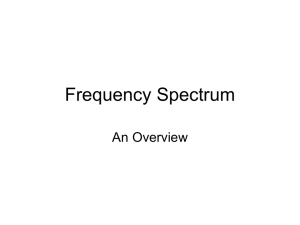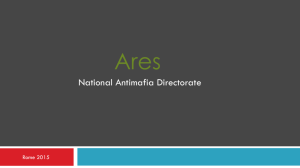Connecticut ARES Region 3
advertisement
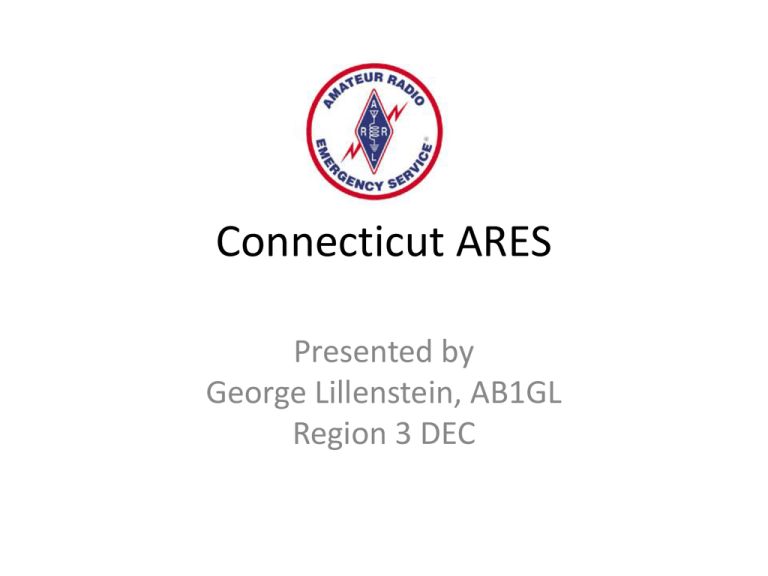
Connecticut ARES Presented by George Lillenstein, AB1GL Region 3 DEC Who/What is ARES? The Amateur Radio Emergency Service • Licensed amateur radio operators who volunteer for emergency communications • “Amateur” means unpaid; not unskilled • To hold an appointed rank must be an ARRL dues-paying member • The Field arm of the ARRL, an umbrella organization representing US hams; 160,000 members; publishers of QST magazine and many others. The World – 3 ITU Regions US Regulatory Jurisdictions American Radio Relay League • An umbrella NGO for U.S. amateur radio operators. Divides country into Divisions New England Division • Divided into Sections. State of Connecticut is one Section. Connecticut ARES Regions ARES Section Org Chart CT ARES Region 3 EC’s Two ARES missions: • Support partner agencies DEMHS, Red Cross, Salvation Army, Public Health, MARS (not Middlesex, the other one), NWS, VOAD • Provide “last mile” message handling to anyone when public carriers can’t Who needs ham radio? Who does ARES serve? Some agencies who call upon ARES to supply radio operators in an emergency: • CT DESPP/DEMHS ARES plays a role in the Governor’s EPPI severe weather drills. SPARC hams at the Armory coordinate ham efforts with the ARES DMR net during storms, alerts, drills. • Hospitals • The Red Cross ARES supplied hams for shelters in Region 4 during storm Juno • The National Weather Service ARES runs nets on ham repeaters. NWS hams collect ground observations from ham spotters via IRLP nodes • The Salvation Army • MARS (no, not the Middlesex club) • Civil Air Patrol • Charitable organizations holding large public events – marathons, bike races, walks, parades, fairs What do we do? • During emergencies where standard comm methods are jammed or not working, we pass vital information to served agencies, such as numbers of beds available, supplies requested, wires/trees down, etc • During public service events, we report on progress and watch for participants or members of the public needing assistance or report developing safety issues How do we do it? • ARES members use their own equipment • Some served agencies provide us with prepositioned antennas or rigs • HT’s, Mobile rigs, base rigs. Go Boxes. • Antennas – anything that gets the job done. We buy ‘em, build ‘em, McGuyver ‘em • Power – all our radios work on 13.8v DC or less. ARES / RACES / Huh? • RACES is a protocol, not a group Goes into effect when US President invokes emergency under War Powers Act of 1934. Otherwise can only use ham frequencies for 1 hr per week and two 72-hr drills per year. • Emcomm teams report to a town official • If activated by FEMA, units should be led by COMM-L, consist of COMM-T and RADOS. • If by DESPP, then Auxcomm operators • Emcomm teams must be activated by a civil preparedness officer • Emcomm teams are sworn as state employees for insurance purposes • Mostly function in municipal facilities – EOC’s, shelters ARES/RACES/Huh? More • ARES is non-governmental, private, non-profit • Activated by ARRL appointed leaders, sometimes at request of “partner agencies” • Members report to their ARES EC • ARES members often respond from home or mobile • ARES members use their own equipment • ARES holds its own annual drill – the S.E.T. (Simulated Emergency Test) • ARES training requirements are optional ARES Training suggestions • ARRL EC-001 • ARRL EC-016 • Skywarn weatherspotter • Seminars in digital communications, antenna building, etc held at ARES meetings or hamfests The “Core Four” classes given by FEMA, required by most partner agencies, available free on line: • FEMA ICS-100 • FEMA ICS-200 • FEMA ICS-700 • FEMA ICS-800 Whats our plan for 2016 • Start a new training cycle for ARES Region 3 from the beginning • Start with orientation and structure • Revise/review Emergency Operations Plan • Revise/review frequency listing • Train in Message Handling • Build better antennas More to do in 2016 • Get more operators able to liaise with NTS via both voice and digital • More HF operators capable of NVIS • Support DMR • Build “Go boxes” • Train as Net Control, Shadow, Relay Station To sign up for membership www.ctares.org The Region 3 web site: www.ctares-region3.org Where to go from here? • Visit the ARRL web site at www.arrl.net • Visit the state ARES web site at www.ctares.org • Visit the Region 3 web site at www.ctaresregion3.org • Read QST magazine • Join a local repeater club – volunteer for Field Day and public service events • Get on the air ARES Region 3 DEC Contact Info George Lillenstein 39A Downey Drive Manchester, CT 06040 860 716-3367 (Cell phone) email: dec@ctares-region3.org or AB1GL@arrl.net

